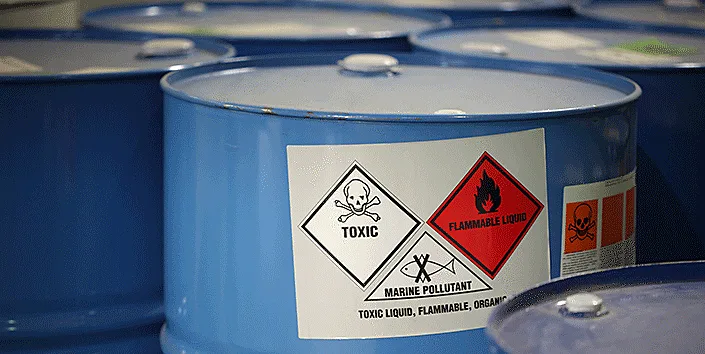Hazards can be grouped in the following categories:
Biological: Living organisms, or products of living organisms, that can be toxic, resulting in illness or disease to humans (e.g. bacteria, viruses, insects, plants, birds, animals, and humans).
Chemical: Inanimate toxic substances that can cause bodily harm. Chemical hazards take many forms such as gases, vapours, dust and fumes.
MSD: An injury to any part of the musculoskeletal system (e.g. muscle, tendons, ligaments, nerves, joints, etc.) caused by repetitive movements, improper workstation set-up, etc.
Physical: Forms of energy that can harm the body when not controlled (e.g. electricity, extreme temperatures, noise, vibration, radiation, magnetic fields, etc.).
Psychosocial: Conditions or activities that adversely affect physical, mental and/or emotional wellbeing (e.g. workplace harassment, stress, violence, etc.)
Safety: anything that may cause injury or loss of life (e.g. slipping/tripping hazards, inappropriate machine guarding, equipment malfunctions, etc.).
See the Downloads section for information on different workplace hazards.
Controlling Hazards
Each identified or recognized hazard will be assessed and controls put in place to ensure that activities can be performed with maximum safety. Hazard control is the process of either eliminating, substituting or decreasing exposure to a hazard.
This chart outlines the location where controls can be applied, beginning at the source.
| At the Source | - Elimination
- Substitution
- Isolation
|
| Along the Path | - Ventilation
- Barriers, Guarding
- Administrative - Housekeeping, Lockout/tag out, Job rotation, Job cross training
|
| At the Worker | - Training
- Personal Protective Equipment (PPE)
|
Hazard Recognition & Reporting
As the employer, you need to understand the health and safety risks in your workplace. You must also appoint competent supervisors, which means that they must understand the hazards of the work they’re organizing or directing. Knowing your hazards and understanding the risk they pose, will help you prioritize other elements of your program, including orientation, training, inspections and preventative maintenance.
See the Resource section for a Hazard Risk Assessment Tool and other hazard resources.
Hazard Assessment
There are different ways to demonstrate an understanding of workplace hazards. Many firms choose to document this information by following the RACE model, which takes you through a systematic process to recognize, assess, control and evaluate hazards.
The RACE Model
RACE
| Steps | Examples |
| Recognize | Identify the existing and potential hazards that your workers could be exposed to. | - Observe the workplace people, equipment, materials, environment and processes
- Review inspection and hazard reports
- Review past injuries and near-misses
- Ask for employee input
|
| Assess | Determine the level of risk for each hazard. This can help determine priority for action. | - Consider how many people work with or around the hazard and how frequently they are exposed
- Consider the likely consequences if a hazard is not controlled effectively
|
| Control | Identify the most effective actions to reduce or manage the level of risk. Consider the hierarchy of control to identify suitable controls. Remember to follow any laws, regulations or codes that apply to the hazard. | - Can the hazard be eliminated or substituted for a less hazardous option
- Are there engineered controls to reduce risk (e.g. guarding)
- Administrative controls (e.g. job rotation, training, safe work procedures and signage)
- What is the correct personal protective equipment for the work
|
| Evaluate | Review whether or not the control was implemented properly. Ensure that no new hazards have been created as a result. | - Observe that control has been implemented and is working as planned
- Ask employees for feedback
- Make improvements as required
|
Reporting Hazards
It is the duty of all workers to report hazards to their supervisor immediately. You can make it easy for workers to report hazards by establishing a simple process such as text messaging or a central email address. Another option is to implement Hazard Report Form and keep blank copies in each department. Be sure to keep track of all hazards being reported and any solutions you implement. This will help you to identify trends and support your ‘due diligence’.
See the Downloads section for a sample Hazard Report Form.

